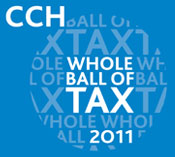| Home | About Us | Order Products | Press Center | Customer Service | Career Opportunities |

CCH can assist you with stories, including interviews with CCH subject experts.
Also, the 2011 CCH provides special CCH Tax Briefings on key topics at CCHGroup.com/Legislation.
|
Wealthier Taxpayers to Benefit from Full Phaseout of Income Restrictions for Itemized Deductions and Exemptions, CCH ExplainsOther Taxpayers Still Benefit from Above-the-line and Enhanced Standard Deductions(RIVERWOODS, ILL., January 2011) – High-income taxpayers may be able to reduce their taxes even further with the repeal of the itemized deduction income restrictions, according to CCH, a Wolters Kluwer business and a leading provider of tax, accounting and audit information, software and services (CCHGroup.com). “Previously, many high-income taxpayers were forced to take the standard deduction because their earnings restricted the amount of the itemized deductions they could claim,” said CCH Principal Federal Tax Analyst Mark Luscombe, JD, LLM, CPA . “However, with income restrictions lifted, they are now able to claim all allowable itemized deductions to further reduce their taxes.” Historically, the number of itemized deductions and personal exemptions a taxpayer could claim phased out as their income increased. However, the Bush-era tax cuts began to steadily chip away at the phase out. As a result, in 2010, high-income taxpayers are not required to reduce the amount of their itemized deductions or exemptions when their adjusted gross income (AGI) exceeds a certain amount. The repeal was phased in over a five-year period starting in 2006 and set to expire after 2010, bringing back income limits on the amount of itemized deductions and exemptions taxpayers could take based on their income. The Tax Relief, Unemployment Insurance Reauthorization and Job Creation Act of 2010 (2010 Tax Relief Act), however, has extended the repeal for two years, through 2012. Allowable Itemized DeductionsWhile the income restrictions have been lifted for claiming itemized deductions, other restrictions remain. For example, miscellaneous itemized deductions can only be taken to the extent they exceed 2 percent of a taxpayer’s AGI. Miscellaneous itemized deductions generally fall into one of three categories:
While most itemized deductions are considered miscellaneous, several other common deductions are not and they also are not subject to the 2-percent floor. These include:
All itemized deductions are claimed on Form 1040 Schedule A. However, this is one of the tax forms that the IRS has announced will be affected by last-minute tax law changes. As a result, taxpayers claiming itemized deductions will need to wait to file their tax returns until mid to late February once the IRS has programmed its systems and provided updated forms. (For detail on the average itemized deductions taken by taxpayers, see the chart in Release 29.) Deciding Whether to Itemize or Take the Standard DeductionTaxpayers need to choose whether they want to itemize or take the standard deduction. Generally, people choose to itemize if their itemized deductions exceed their standard deduction. For 2010, the standard deduction is $5,700 for single filers ($11,400 for joint filers). However, certain taxpayers, including nonresident aliens and dual-status aliens, are not eligible to take the standard deduction and must itemize deductions. “In the past, wealthier people tended to itemize because they had more deductions,” said Luscombe. “On the other hand, the standard deduction often helps people at lower income levels by giving them a greater deduction than they’d be able to realize through itemizing.” In addition to the normal standard deduction, taxpayers may also be eligible for a larger deduction if they or their spouse is blind or was born before January 2, 1946, or both. The extra amounts for age and blindness can be claimed on Form 1040 or 1040A. Additional standard deductions for disaster losses, real estate taxes and new motor vehicle taxes expired at the end of 2009. In special circumstances, a taxpayer may claim an additional standard deduction in 2010 for a 2009 disaster where the loss was realized in 2010 or for a 2009 vehicle purchase where the tax was paid in 2010. Additionally, taxpayers qualifying for the deduction for new car sales and use taxes can take it in this section of Form 1040 even if they itemize – but they can’t take an itemized deduction for sales taxes, only for state and local income taxes. Additional Deductions Available to Taxpayers Who Don’t ItemizeSeveral other deductions are available to taxpayers who don’t itemize. These include:
All of the above are available on Form 1040 or 1040A. As with taxpayers claiming itemized deductions, taxpayers claiming the tuition and fees or the teachers’ classroom expense deductions also will need to wait to file their tax returns until mid to late February once the IRS has programmed its systems and provided updated forms. The following deductions are available only on Form 1040:
About CCH, a Wolters Kluwer businessCCH, a Wolters Kluwer business (CCHGroup.com) is a leading provider of tax, accounting and audit information, software and services. It has served tax, accounting and business professionals since 1913. CCH is based in Riverwoods, Ill. Wolters Kluwer is a leading global information services and publishing company. Wolters Kluwer is headquartered in Alphen aan den Rijn, the Netherlands (www.wolterskluwer.com). -- ### -- nb-11-32
|
© 2024, CCH INCORPORATED. All rights reserved. |
Back to Top | Print this Page | ||||||||||||||||||